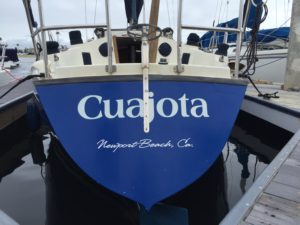
There are two ways to prove ownership of a US flagged vessel, Coast Guard documentation and state registration. All vessels over 5 net tons are eligible for Coast Guard documentation and the form of ownership record or title is an owner’s choice. Lenders generally insist on vessels being documented so they may be the subject of a Preferred Ship Mortgage.
Registered vessels must display the registration number and a current registration decal on both sides of the bow, while documented vessels must display the name and the hailing port on the transom or on both hull sides.
Naming a vessel can be a difficult decision, often reflecting a family member’s name or referencing the business of the owner in some clever way. Less thought is put into the hailing port, but the hailing port is a choice. It does not have to be the place where the boat is stored, where you live nor does it have to have any actual significance or relevance to your life. What do you think are the parameters for choosing a valid hailing port?
Recently I have seen hailing ports including Huntington Harbor, Mission Bay and Surf City. To my surprise Huntington Harbor and Mission Bay were both the hailing ports actually on the document. The owner of the vessel with hailing port Surf City liked Huntington Beach’s “official” nickname, but he was not in compliance with federal regulations as the hailing port on the document did not match the hailing port on the transom. As a result of these unusual haling ports, we researched the rules for hailing ports.
Throughout my career it had been my understanding that the hailing port had to be an actual city in the United States or a US territory. Some had told me that a hailing port had to have a post office, but I had never researched the actual rule, and I wondered what made a location a “city”?
My thanks (and a belated Happy Birthday) to Bernadine Trusso of Dona Jenkins Maritime Document Service, Inc. Bernadine discussed this issue with an officer in the Coast Guard and they confirmed that the website used by documentation personnel is https://geonames.usgs.gov/apex/f?p=138:1:0:::::
To determine if a location is a valid hailing port, click the “Query” tab, fill in the “feature name” and the “state” and then hit the “Send Query” tab. If the feature name comes up as written, such as Point Loma, the location is a valid hailing port. In the case of Point Loma the class is cape. In the case of Mission Bay the class is bay and in the case of Leucadia the class is populated place. The class of the location is irrelevant according to our source, as long as the feature name comes up as you have searched it, without additional words.
The name and the hailing port must be displayed externally on the vessel, either on both sides of the hull or on the transom. The hailing port must include the place and a state, territory, or possession of the United States. The state may be abbreviated.
We often find hailing ports without the necessary state, territory or possession included. We often find names and hailing ports from prior documents, legally requiring modifications to the current documented name and hailing port. We occasionally find registration numbers on documented boats (a no no), documentation numbers on the exterior of boats (unnecessary) or no identifying numbers, name or hailing port (begging to be boarded by the authorities).
Registered boats may have names and hailing ports, but these boat names are decoration, an expression of individuality, and can be changed at any time as they are not legally significant. Based on my newly found resources, Huntington Harbor and Mission Bay are in fact valid hailing ports, but not Surf City and now you have the ability to be as creative with your hailing port as with your vessel’s name.